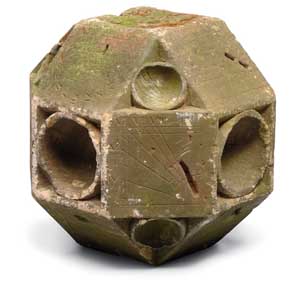
[photo credit: Christie's ]
|
A rare stone, polyhedral sundial discovered in England, and thought to date from the Scottish renaissance, sold April 7, 2011 for £16,250 (\(26,500) at Christie's South Kensington, London.
The sundial discovered in 1974, and thought to date from the Scottish renaissance, went on the auction block this April as part of Christie's Travel, Science and Natural History sale in London. The dial is made of stone and technically described as a polyhedral dial, with several independent sundials arranged on different facets of the stone. Pre-auction estimates placed a value somewhere between £7000 and £10,000 (\)11,400 and $16,300) but sold for nearly three times the initial estimate.
It is only by chance this dial was rescued from a potentially less illustrious end. The original owner found it partially buried in the ground in Herfordshire England, dug it up and used it as a garden ornament, even going so far as to grow strawberries in the scaphe dials (the semi-spherical "bowls" seen on the vertical faces in the image). After accompanying the owner during several house moves, a sundial enthusiast happened to see the unusual object and recognized it for the rarity that it is. A technical analysis of the dial locate its origin somewhere just south of Edinburgh sometime around 1630 to 1730. In the past twenty years, only two other examples of this kind of dial have come onto the market.
